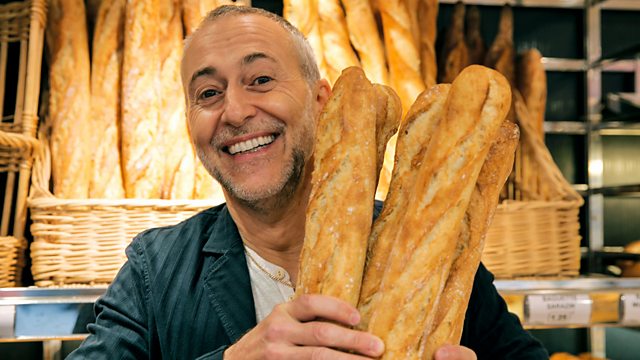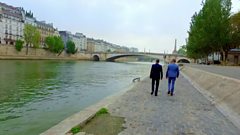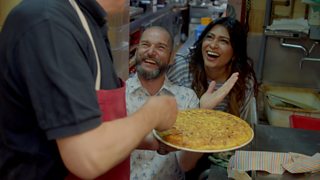
Paris
Fred and his former boss, chef Michel Roux Jr, are in Paris experiencing the signature dish of a classic restaurant and enjoying the simple pleasures of a perfect ham baguette.
This week’s episode sees Fred Sirieix visiting Paris, the capital city of French gastronomy with his friend and former boss, Michel Roux Jr.
Michel has been a life-long disciple of classic French cuisine – perfected in his two-Michelin-starred restaurant Le Gavroche, and learned from his family and as an apprentice in Paris as a teenager.
Driving round the Arc de Triomphe in a vintage Citroen, Michel admits that ten or 20 years ago Paris lost its way as a dining destination, but that now it is back on form and a combination of attitude and amazing heritage mean that it’s home to some really incredible places to eat.
Paris boasts more than 40,000 restaurants, brasseries and bistros, but the place that Michel really wants Fred to experience is one of the most famous. La Tour d’Argent was first opened as an inn in 1582. Now located on the left bank of the Seine, with stunning views of Notre Dame, it is a restaurant that epitomises the traditions of French fine dining. Michel wants to show Fred the best of La Tour’s heritage by ordering a dish that as been on the menu since 1890 consisting of duck served in two courses.
The first sees the roast duck carved at the table by a waiter, who then places the carcass into a heavy sliver press to extract highly flavoured juices which are mixed with cognac and madeira wine to create a rich sauce. The second course is duck leg served with fresh almonds and turnips. Fred and Michel remark that this is a far more contemporary dish, and realise that La Tour has a challenge on its hands to uphold its traditions while adapting to compete in Paris’s modern restaurant scene.
Modernising their menu will be part of this mission, but it is not just food that makes La Tour special, it is also wine. The wine list is a massive book that weighs four kilograms and Fred and Michel visit the cellar, run for almost 40 years by an old friend of Michel’s, David Ridgway. The cellar houses 320,000 bottles of 15,000 different wines – some retailing at prices between €60 and €25,000. And with such a vast collection the restaurant needs a special system to make sure the staff can rapidly locate the right bottle - which starts when waiters drop a wine order seven floors down a special shoot to a trainee wine waiter who consults a guide to learn which rack holds the specific type and vintage, so he can send the bottle up to the dining room in its own lift.
Michel admits that meal at La Tour D’Argent is an expensive indulgence, but with award-winning chef Phillippe Labbe in the kitchen with as many as 20 sous chefs and 20 front of house staff, the experience is unforgettable. However Michel knows that classic French cuisine doesn’t have to come with fancy wine and a big price tag, so the next stop is a place that is reviving one of the simplest and cheapest French classics – the jambon-beurre or ham baguette. Fred is delighted - he loves a good ham baguette and is happy to try the €5.50 version on sale at Jambon Beurre in Rue St Honoré. Frustrated by a distinct lack of good traditional sandwiches, friends Stephan and Roldolph quit their day jobs as bankers and set out to produce the best jambon-beurre in Paris, by sourcing the finest quality ingredients.
Fred and Michel are impressed, the sandwiches are delicious. Michel wants to learn what makes the bread so special, and spends a morning making his first ever baguette in the award-winning bakery where Phillippe Gosselin makes 2000 baguettes by hand a day, including loaves to be served at the Presidential Palace. Meanwhile, Fred visits Doumbea, the last place in Paris to manufacture ham using a 17th-century Parisian technique. Both businesses are perfect examples of how preserving traditions can be the key to success in the contemporary food scene.
The final stop on Michel’s itinerary also has a rich history that helps it stand out in Paris’s crowded restaurant market. Brasserie La Couple was in Montparnasse in 1927 and immediately became popular with cultural icons Picasso, Sartre and Hemingway. La Coupole has the biggest dining room in Paris, seating 300 with a further 100 on the terrace. There are more than 30 dishes on the menu and it is designed to offer something tempting at a range of prices, starting with a set menu at just €19.50. But it is the seafood platters, sold and prepared from a stand in the main dining area, that catch Fred and Michel’s eye.
Shellfish constitutes an incredible 20% of the brasserie’s sales but sourcing these quantities is a huge challenge. To find out how they do it, Fred takes a trip to Rungis, the 578 acre food market that supplies Paris’s restaurant industry. Back in the brasserie Fred and Michel join the seafood counter to help prepare a lavish seafood platter, displaying each ingredient to delight the eye. Both agree that here, at Jambon Beurre and at La Tour D’Argent, the mixture of tradition, food skills and French passion make eating out an incredible exp
Last on
More episodes
Previous
Clip
-
![]()
Fred in Paris with Michel Roux
Duration: 00:54
Music Played
Timings (where shown) are from the start of the programme in hours and minutes
-
![]() 00:03
00:03Sidney Bechet
Si Tu Vois Ma Mere
-
![]() 00:17
00:17Charles Trenet
Douce France
-
![]() 00:42
00:42Sam Butera & the Witnesses
I love Paris
Credits
| Role | Contributor |
|---|---|
| Presenter | Michel Roux Jr |
| Production Company | Outline Productions Ltd |
| Series Producer | Katy Fryer |
| Executive Producer | Helen Veale |
| Production Manager | Clare Crossley |
| Producer | Mike Radcliffe |
Broadcasts
- Wed 31 Jul 2019 20:00
- Mon 5 Aug 2019 19:00
- Thu 15 Aug 2019 00:15
- Wed 1 Jul 2020 19:00�������� Two except Wales & Wales HD
- Sun 5 Jul 2020 18:00�������� Two Wales & Wales HD only



